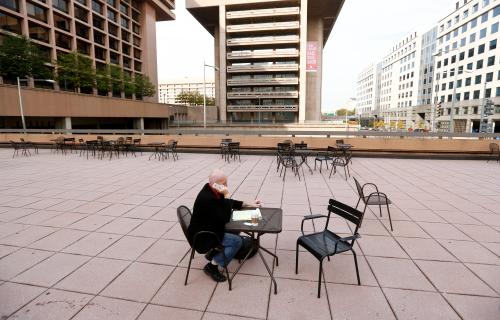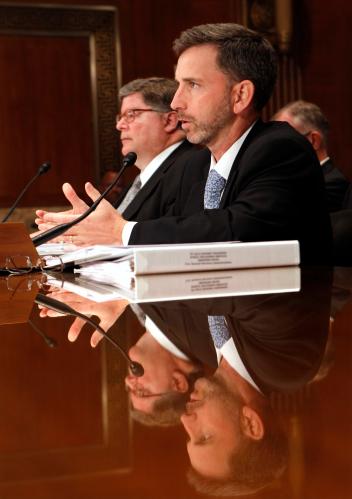Last week, the General Services Administration (GSA) made front-page news when it cancelled its four-and-a-half year plan to exchange the crumbling J. Edgar Hoover Building for a new FBI headquarters in suburban Washington, DC. While regrettable, this decision need not take the process of getting a new headquarters back to square one, as commentators and critics have assumed. But to salvage the effort, members of Congress and local political officials need to redirect their anger from GSA to the real culprit: perverse budget scorekeeping rules that prevent the use of private financing to build and repair structures for the federal government’s own use.
Why GSA resorted to barter
The need for a new FBI headquarters has been well documented. Built in the early 1970s to store mountains of paper files, the Hoover building no longer serves the agency’s needs in a digital age, and its location right on Pennsylvania Avenue—six blocks from the White House—makes proper security protection impossible. Hoover is also too small to house the thousands of agents hired after 9/11; half of headquarters staff is dispersed in some 20 leased locations, inhibiting the kind of close collaboration the FBI has sought to encourage in the aftermath of 9/11.
In 2013, GSA rekindled the long-dormant discussion of a new FBI headquarters by announcing that it wanted to swap the current FBI site for a new, larger facility, with the site and developer to be chosen competitively. GSA’s unstated rationale for invoking its little-used property exchange authority to was to avoid the congressional appropriations process. When GSA sells a building, the proceeds go into the Federal Buildings Fund (FBF), which is where agencies send their monthly rent checks so that GSA can operate and maintain federal facilities and construct the occasional new building. GSA can’t “earmark” sale proceeds for the construction of a replacement building. Moreover, although FBF resources have always been tight, since 2010, appropriators have taken billions of dollars out of the Fund to cover unrelated costs such as Department of Treasury salaries, forcing GSA to defer critical maintenance and forego much-needed new construction.
While allowing it to bypass appropriators, GSA’s innovative exchange plan had one major drawback: the winning developer would not be able to take possession of Hoover until it had completed construction of the new headquarters building, and that lag period would reduce what a developer was willing to pay for the site.
But if the exchange process wasn’t perfect, the alternative—a traditional appropriation—was a non-starter. Under federal budget rules, capital investments must be fully funded in advance. Congress had no appetite for finding the $1-2 billion needed to advance-fund a new FBI headquarters, and the Office of Management and Budget (OMB), although supportive of GSA’s barter plan, thought the project should ideally be done in phases and paid for with existing FBI funds.
There was another “option”—but it too was a non-starter. Under GSA’s “outlease-leaseback” authority, a developer could build a new facility to the FBI’s specifications on federally owned land and lease it back to the FBI. At the end of (say) 30 years, the developer—having recouped its investment—would transfer ownership of the building to the federal government. But that seemingly sensible approach ran afoul of budget scorekeeping (scoring) rules that OMB, with strong backing from the Congressional Budget Office and the House and Senate Budget Committees, enforces with an iron fist. When GSA lawyers devised an approach to outlease-leaseback that was technically compliant with the scoring rules, OMB rejected it outright as exploiting a loophole.
Circular A-11: The most important OMB document you never heard of
The scoring rules for federal real property are codified in Appendix B of OMB Circular A-11, which sets out criteria for distinguishing a capital lease from an operating lease. The rules preclude the use of private financing to construct or renovate a facility if ownership of the facility is transferred to the government at the end of the lease. They do this by requiring the full, net present value of such a project, which constitutes a capital lease, to be recorded (scored) in an agency’s budget in the first year of project activity—the budgetary equivalent of direct federal funding. By contrast, if the federal government simply leases a building for 10 or 15 years, the transaction is considered an operating lease and can be scored (i.e., budgeted for) year by year. (See my 2014 blog, “Reforming Federal Property Procurement: The Case for Sensible Scoring.”)
The scoring rules were put in place in 1991 in part to nix agencies’ use of long-term leases to buy physical and real property. These “lease purchases” were thought to hide the government’s long-term cost commitment, leading to suboptimal decision-making in the annual budget process. The other historic rationale for the scoring rules was cost: budget agencies have long argued that it is less expensive for the federal government to buy or renovate a building directly than to finance it privately, because of the lower rate at which the U.S. Treasury can borrow.
The cost argument is tricky: The federal government’s interest-rate advantage is often swamped by other cost factors, such as the longer completion time for federally funded projects compared to those that are privately financed and managed. That issue notwithstanding, the premise underlying Circular A-11—that federal agencies would be able cover the large funding spikes that direct purchases of new buildings and building renovations entail—has proved false over a 26-year period of unrelenting budget pressure. The result has been a textbook example of unintended consequences: lacking the budgetary resources to meet genuine facility requirements, federal agencies have resorted to practices more costly—and no more transparent—than the ones Circular A-11 was designed to combat. GSA has been forced to use expensive short-term operating leases to meet what amount to long-term space needs, and DOD’s military bases are a study in the high cost of deferred maintenance.
One illustration of the perversity of Circular A-11 scoring rules is the new (2006) Department of Transportation (DOT) headquarters, a leased facility that GSA sited on the Anacostia River in Southeast DC, in part to spur development there. In 2021, having spent $675 million to lease a building that cost only $400 million to build, GSA will have to sign another 15-year lease. The federal government will have no equity— note that property values near the DOT headquarters have soared because of federally anchored development—and no end in sight to costly rent payments.
Make the New FBI Headquarters a Pilot Project in Private Financing
GSA cancelled the exchange process on the grounds that it could not proceed without having a full appropriation for the difference between what developers were offering for Hoover and the (now inflated) cost of the new headquarters. Although that rationale is insufficient—privately, GSA never expected Hoover to cover the full cost of the new headquarters— the plan to exchange Hoover for (part of) a new facility appears to be dead.[1]
Nevertheless, members of Congress and local political officials who have lashed out at GSA have the wrong target: GSA would have built a new, privately financed FBI headquarters years ago had it not been for the scorekeepers at OMB. Nor is it correct to assume, as critics and commentators have been quick to do, that the four-plus years of effort and millions of dollars spent by candidate jurisdictions and would-be developers have been for naught.
The current crisis creates an opportunity to pursue the previously verboten option. If the Trump administration moves quickly to make the FBI headquarters a pilot project in the use of private financing to construct a federal facility, it may be able to preserve the results of GSA’s procurement process to date, including the multi-year environmental reviews of candidate sites that are the long pole in the tent. The administration probably does not need congressional approval to proceed, because GSA already has the authority to do an outlease-leaseback project. (That said, congressional buy-in may be helpful, as Congress will eventually need to approve the FBI’s lease payments to the developer.) But what is needed is a memorandum from OMB stating that this pilot project will be scored on an annual basis, meaning that the budgetary cost can be recorded over the term of the project and not entirely in the first year.
Many government managers are hopeful that President Trump, who knows buildings and understands the cost of deferred maintenance better than any of his predecessors, will want to rethink the perverse constraints on investment in federal real property, with an eye to reducing excess capacity in the federal inventory, moving agencies out of expensive leased space into federal buildings where appropriate, cutting long-term maintenance costs, and improving agencies’ ability to perform their missions. A reexamination of Circular A-11 is the key to that effort. Making the new FBI headquarters a pilot project in more flexible financing is valuable in its own right and a smart way to start that much-needed reexamination of our approach to government buildings.
Dorothy Robyn was the Deputy Under Secretary of Defense for Installations and Environment from 2009-2012 and the GSA Public Buildings Commissioner from 2012-2014.
[1] That’s unfortunate: GSA recently used its exchange authority to ink a $750 million deal with the Massachusetts Institute of Technology (MIT). As the competitively selected developer, MIT will build a new research facility for DOT’s Volpe Center in Cambridge, MA, in exchange for 14 acres of Volpe land that had been used for surface parking. The deal will net taxpayers more than $200 million and allow MIT to redevelopment prime property adjacent to its campus.
The Brookings Institution is committed to quality, independence, and impact.
We are supported by a diverse array of funders. In line with our values and policies, each Brookings publication represents the sole views of its author(s).











Commentary
To keep the FBI headquarters project on track, make an exception to the scoring rules
July 20, 2017